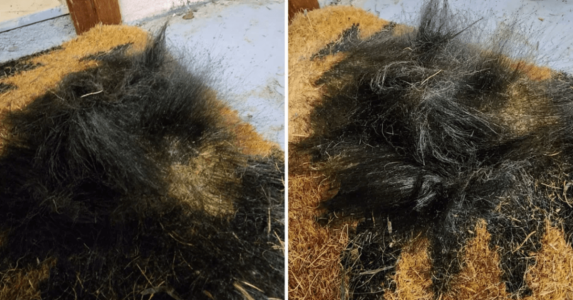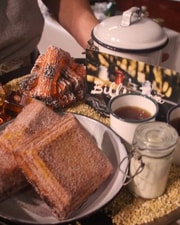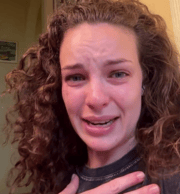Mysterious growth in woman's home leaves her baffled. What could it be?
- Replies 8
You can never really tell what's lurking beneath the surface of a home, but for most of us, it wouldn't be quite as mysterious as what one Sydney woman recently stumbled upon.
The homeowner, who prefers to remain anonymous, found something so odd and unusual growing in her garage it has even left experts at a loss.
The woman took to her local Facebook page on Wednesday, hoping to uncover the identity of the 'super weird' growth, which was spotted on her doormat.
'Obviously, I had zero idea what it was, so I asked on [my Facebook group],' she told Yahoo News.
'There was a black pattern on the mat, so [it was] probably not obvious until it got that big.'
The photos she posted showed a long, black, hairy substance covering the bottom of her doormat. It looked like a furry creature from behind, with some bystanders joking it was something from a sci-fi movie, but nobody seemed quite sure what it was.
The woman refused to touch it for fear of spreading an unknown substance and instead asked her followers on Facebook to identify it.
The joke was that it could be a 'gremlin' or a monster from Stranger Things (a sci-fi horror drama on the streaming website Netflix), but in reality, some people suggested it could be a species of household mould known as Alternaria—a major plant pathogen that can often grow indoors.
Yahoo News asked Dr Cécile Gueidan, Senior Research Scientist at the Australian National Herbarium in Canberra, for her thoughts.
While she couldn't confirm the identity without a sample, the fungus specialist said she did not think it was Alternaria.
Professor David Catcheside from Flinders University also agreed, saying that it is most likely a saprophyte doing its job of recycling organic matter.
To those unfamiliar, a saprophyte is an organism, usually a fungus or bacterium, that lives on and feeds off dead or decaying organic matter.
It is unknown what, exactly, is living or growing on the mat, but its presence is enough to warrant caution from the experts.
Most forms of mould produce spores which can cause an allergic reaction in some and worse reactions in people with weakened immune systems. For this reason, the woman did the right thing and threw out the doormat as soon as possible.
Professor Catcheside also advised cleaning the area with a disinfectant, then added: 'The mould would require moisture to grow, so it would be wise to replace the mat with one that is rot resistant, such as one not composed of natural fibre.'

The most crucial action to prevent mould in your home involves minimising moisture.
Fix any leaks in plumbing, roofs, or other building faults promptly. Keep gutters clear and well-maintained. Opt for a vacuum cleaner with a HEPA (high-efficiency particulate air) filter. Avoid placing mattresses on the floor or poorly ventilated surfaces.
If possible, vacuum and/or rotate mattresses regularly. Also, improve air circulation around furniture by moving it away from the walls. These steps will help safeguard your home from mould growth and maintain a healthier living environment.
Whatever the issue is, we hope the woman has seen the last of it. Members, do you have similar stories of dealing with mould or unidentified growths in your home? Share them with us in the comments below!
The homeowner, who prefers to remain anonymous, found something so odd and unusual growing in her garage it has even left experts at a loss.
The woman took to her local Facebook page on Wednesday, hoping to uncover the identity of the 'super weird' growth, which was spotted on her doormat.
'Obviously, I had zero idea what it was, so I asked on [my Facebook group],' she told Yahoo News.
'There was a black pattern on the mat, so [it was] probably not obvious until it got that big.'
The photos she posted showed a long, black, hairy substance covering the bottom of her doormat. It looked like a furry creature from behind, with some bystanders joking it was something from a sci-fi movie, but nobody seemed quite sure what it was.
The woman refused to touch it for fear of spreading an unknown substance and instead asked her followers on Facebook to identify it.
The joke was that it could be a 'gremlin' or a monster from Stranger Things (a sci-fi horror drama on the streaming website Netflix), but in reality, some people suggested it could be a species of household mould known as Alternaria—a major plant pathogen that can often grow indoors.
Yahoo News asked Dr Cécile Gueidan, Senior Research Scientist at the Australian National Herbarium in Canberra, for her thoughts.
While she couldn't confirm the identity without a sample, the fungus specialist said she did not think it was Alternaria.
Professor David Catcheside from Flinders University also agreed, saying that it is most likely a saprophyte doing its job of recycling organic matter.
To those unfamiliar, a saprophyte is an organism, usually a fungus or bacterium, that lives on and feeds off dead or decaying organic matter.
It is unknown what, exactly, is living or growing on the mat, but its presence is enough to warrant caution from the experts.
Most forms of mould produce spores which can cause an allergic reaction in some and worse reactions in people with weakened immune systems. For this reason, the woman did the right thing and threw out the doormat as soon as possible.
Professor Catcheside also advised cleaning the area with a disinfectant, then added: 'The mould would require moisture to grow, so it would be wise to replace the mat with one that is rot resistant, such as one not composed of natural fibre.'
Key Takeaways
- A baffled homeowner in Sydney discovered a strange 'super weird' growth attached to her doormat.
- The growth resembled a ball of dark hair, sparking discussion and speculation on a local community Facebook page.
- Some experts suggested it could be some form of household mould, possibly Alternaria, but could not definitively say without a sample.
- The homeowner was advised to remove the growth, dispose of the mat, and clean the area with a disinfectant, as mould can create spores with potential adverse health effects.
The most crucial action to prevent mould in your home involves minimising moisture.
Fix any leaks in plumbing, roofs, or other building faults promptly. Keep gutters clear and well-maintained. Opt for a vacuum cleaner with a HEPA (high-efficiency particulate air) filter. Avoid placing mattresses on the floor or poorly ventilated surfaces.
If possible, vacuum and/or rotate mattresses regularly. Also, improve air circulation around furniture by moving it away from the walls. These steps will help safeguard your home from mould growth and maintain a healthier living environment.
Whatever the issue is, we hope the woman has seen the last of it. Members, do you have similar stories of dealing with mould or unidentified growths in your home? Share them with us in the comments below!








